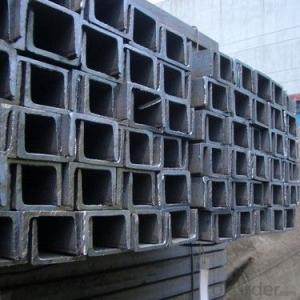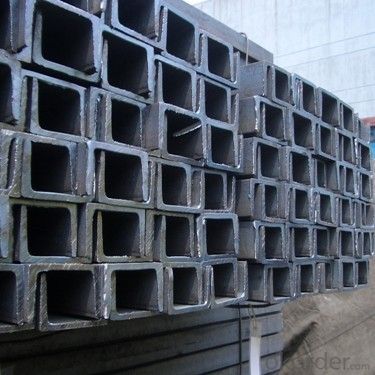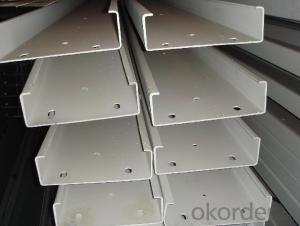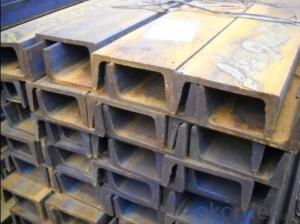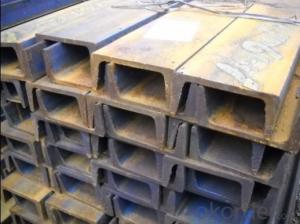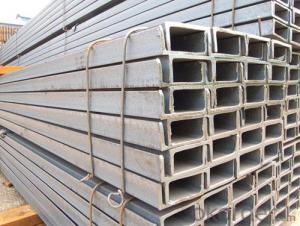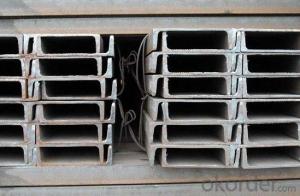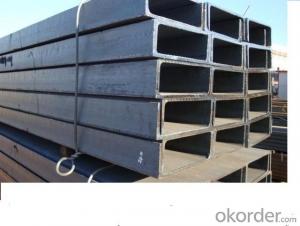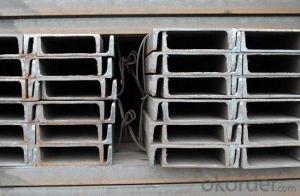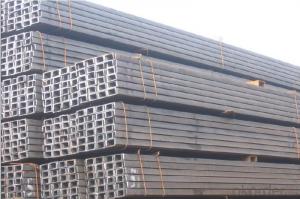GB Standard Steel Channel 140mm with High Quality
- Loading Port:
- China Main Port
- Payment Terms:
- TT or LC
- Min Order Qty:
- 25 m.t
- Supply Capability:
- 10000 m.t/month
OKorder Service Pledge
OKorder Financial Service
You Might Also Like
Product Description:
Specifications of GB Standard Steel Channel 140mm with High Quality:
1. We are definitely specializing in manufacturing and supplying channel steel.
| Standard: | GB/T 6723-86 |
| Sizes: | 140mm |
| Sales Volume/Year: | 10000MT |
| Destination Area: | Middle East, Africa, Southeast Asia |
2.Size, Length and Mass.
| Size(mm) | Length(m) | Mass(Kg/m) |
| 140*60*3 mm | 6m, 12m | 5.864 kg/m |
140*60*4 mm | 6m, 12m | 7.662 kg/m |
| 140*60*5 mm | 6m, 12m | 9.420 kg/m |
| 140*60*6 mm | 6m, 12m | 11.21 kg/m |
Package & Delivery of GB Standard Steel Channel 140mm with High Quality:
The steel u channel will be packed in bundle with steel wire at each end of every bundle and color marking in order to help the customer to recognize his goods more easily at sight.
And steel u channel could be loaded into 20ft or 40ft container, or by bulk cargo. If the weight of each bundle reaches less than 3.5 mt, the loading by break bulk cargo should be choosed. When the weight of each bundle reaches less than 3mt, the loading by container should be choosed.
As for the transportaion from mill to loading port, the truck will be usually used. And the maximum quantity for each truck is 40mt.
All in all, we could do in accordance with customer's request.
FAQ:
Q1: How soon can we receive the product after purchasement?
A1: Within three days of placing an order, we will begin production. The specific shipping date is dependent upon international and government factors, but is typically one month.
Q2: How do you guarantee the quality of our products?
A2: We have established an advanced quality management system which conducts strict quality tests at every step, from raw materials to the final product. At the same time, we provide extensive follow-up service assurances as required.
Q3: The prices are invoicing on theoritical weight or on actual weight?
A3: We can do it in both manners, according to the customers' request.
Images of GB Standard Steel Channel 140mm with High Quality:
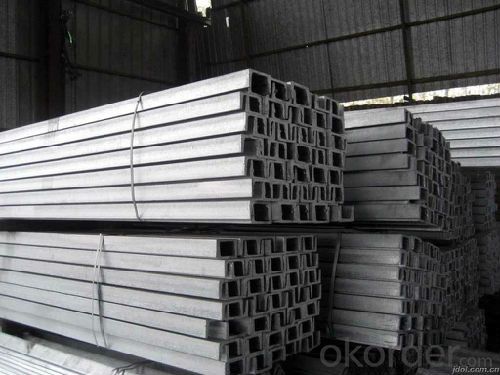
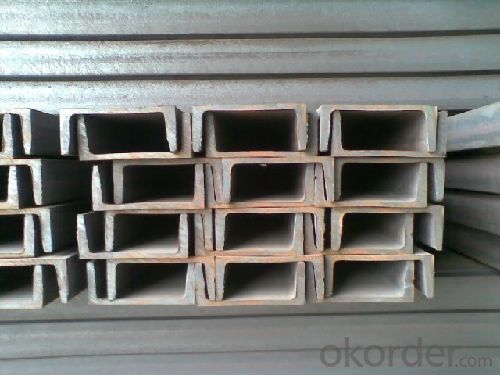
If you would like to get our price, please kindly inform us the standard/material, size and quantity. Thank you very much.
- Q: Can steel channels be used for solar panel mounting?
- Indeed, steel channels have the ability to be utilized for the purpose of mounting solar panels. Opting for steel channels as a mounting solution not only offers robustness and longevity, but also the capacity to bear the weight of the panels and withstand diverse weather conditions. Moreover, steel channels can be effortlessly tailored and adapted to meet the precise demands of the solar panel installation. They furnish a dependable base for the panels, allowing for installation on rooftops, ground mounts, or other structures. Nevertheless, it is crucial to guarantee the proper installation and anchoring of the steel channels to ensure the requisite stability for the solar panels.
- Q: Can steel channels be used for railway track support?
- Yes, steel channels can be used for railway track support. Steel channels are often used as a cost-effective and durable structural support element in various applications, including railway track support. They provide strength, stability, and load-bearing capacity, making them suitable for supporting the weight and forces exerted by trains on railway tracks. Steel channels can be easily fabricated and installed, and they have the ability to withstand harsh environmental conditions and heavy loads. Additionally, their inherent resistance to corrosion makes them a reliable choice for long-term use in railway track support systems.
- Q: What are the different types of connections used for steel channels?
- Various types of connections are utilized for steel channels depending on the specific application and structural needs. Some commonly used connections are as follows: 1. Welded Connections: Welding is a prevalent method for joining steel channels. This process involves melting the channel ends and fusing them together using heat. Welded connections are known for their strength, durability, and excellent load-bearing capacity. 2. Bolted Connections: Bolted connections involve the use of bolts, nuts, and washers to connect steel channels. Holes are drilled in the channels, and bolts are inserted through these holes and tightened with nuts. Bolted connections offer easy installation, flexibility for disassembly, and can be adjusted or replaced if needed. 3. Riveted Connections: Riveting is an older method of connecting steel channels that involves using rivets. Rivets are inserted through pre-drilled holes in the channels and then hammered or pressed to secure them in place. Riveted connections provide strength and stability, although they are less common nowadays due to the labor-intensive installation process. 4. Composite Connections: Composite connections combine different connection methods to enhance overall strength and performance. For instance, a composite connection may utilize a combination of welding and bolting, providing the advantages of both methods. These connections are often preferred for high-load applications or when specific design requirements must be met. 5. Moment Connections: Moment connections are employed to transfer bending moments between steel channels. These connections are designed to withstand rotational forces and provide stability. Moment connections are typically created through welding and require meticulous design and engineering to ensure proper load distribution and structural integrity. It is important to consider factors such as load requirements, structural design, fabrication capabilities, and project specifications when selecting a connection type. Consulting a structural engineer or a professional with expertise in steel channel connections is highly recommended to ensure the appropriate connection type is chosen for a specific application.
- Q: What is the difference between the main keel and the angle steel and the channel steel?
- Channel steel is a strip of steel with a cross section. Section steel with groove shape.Channel steel is a kind of carbon structural steel used for construction and machinery. It is a complex section steel. Its cross section has a groove shape. Channel steel is mainly used in building structure, curtain wall engineering, mechanical equipment and vehicle manufacturing, etc.. In use, it requires better welding, riveting performance and comprehensive mechanical properties. The raw material steel billet for channel steel is carbon or low alloy steel billets with a carbon content of not more than 0.25%. The finished channel steel is delivered by hot forming, normalizing or hot rolling. The specifications are expressed in millimeters of height (H) * leg width (b) * waist thickness (d), such as 100*48*5.3, which means waist height is 100 mm, leg width is 48 mm, waist thickness is 5.3 mm channel, or 10# channel steel. The same height of the channel, if there are several different leg width and waist thickness, also need to add a, B, C on the right side of the model to distinguish, such as 25#a, 25#b, 25#c and so on.
- Q: Can steel channels be used for handrail supports?
- Indeed, handrail supports can utilize steel channels. In construction, steel channels are frequently employed due to their robustness and resilience, rendering them a prime option for handrail supports. They furnish stability and bolster the handrail, guaranteeing its safety and endurance. Furthermore, steel channels can be readily tailored and manufactured to suit particular handrail designs and prerequisites.
- Q: What are the load distribution factors for steel channel beams?
- The load distribution factors for steel channel beams depend on various factors, including the size and shape of the beam, the type of load being applied, and the overall structural design. Load distribution factors help determine how the load is distributed across the beam and its supporting structures. In general, steel channel beams have good load distribution characteristics due to their shape and structural properties. The shape of the channel beam, with its flanges and web, provides stability and enhances load distribution capabilities. Factors such as the span length, the type and magnitude of the load, and the support conditions at both ends of the beam play a crucial role in determining the load distribution factors. For example, a shorter span length generally results in a more uniform distribution of the load, while longer spans may require additional supports or reinforcements to ensure proper load distribution. The type of load being applied, whether it is a concentrated load or a distributed load, also affects the load distribution factors. Concentrated loads, such as those from machinery or equipment, require careful consideration to ensure that the load is evenly distributed across the beam and does not cause localized stress concentrations. Additionally, the design of the supporting structures, such as columns or walls, influences the load distribution factors. Properly designed connections between the beam and its supports help transfer the load efficiently and distribute it evenly throughout the structure. It is important to consult with structural engineers or reference design codes and standards to determine the specific load distribution factors for a given steel channel beam. These factors can vary depending on the specific application and design requirements, and it is crucial to ensure that the beam is designed and installed in accordance with industry standards to ensure safe and efficient load distribution.
- Q: Can steel channels be used in DIY projects?
- Yes, steel channels can be used in DIY projects. Steel channels are versatile and strong, making them suitable for various applications such as building structures, shelving units, and furniture. They can be easily welded, cut, or drilled to fit specific project requirements, making them a popular choice among DIY enthusiasts and professionals alike.
- Q: Do steel channels have any specific thermal expansion properties?
- Yes, steel channels do have specific thermal expansion properties. Like all materials, steel expands and contracts with changes in temperature. The thermal expansion of steel channels is primarily determined by the coefficient of linear expansion, which is a measure of how much the material expands per unit length per degree Celsius (or per unit length per degree Fahrenheit). The coefficient of linear expansion for steel typically ranges between 10 to 13 parts per million per degree Celsius (10-13 ppm/°C). This means that for every degree Celsius increase in temperature, a steel channel will expand by approximately 10 to 13 parts in a million of its original length. It is important to consider the thermal expansion of steel channels in various applications to ensure proper design and functionality. For example, in structures where steel channels are used, such as bridges or buildings, allowance must be made for the expansion and contraction of the channels to prevent stress buildup and potential damage. Expansion joints or other methods of accommodating thermal expansion are typically incorporated into the design to account for these properties. In summary, steel channels do exhibit specific thermal expansion properties, which are determined by the coefficient of linear expansion. Understanding and accounting for these properties is crucial in the design and application of steel channels to ensure their structural integrity and functionality in varying temperature conditions.
- Q: What are the different grades of steel channels?
- Steel channels come in various grades, each possessing unique properties and applications. Some commonly used grades are as follows: 1. A36: The most widely used grade, A36 steel channel finds its application in construction and structural projects. It boasts a minimum yield strength of 36,000 psi and is easily machinable and weldable. 2. A572: A high-strength, low-alloy (HSLA) steel channel grade, A572 offers superior strength and durability compared to A36. It is commonly employed in heavy-duty applications like bridges and buildings. 3. A588: This grade is renowned for its corrosion resistance, making it ideal for outdoor or exposed environments. It is frequently utilized in construction projects exposed to harsh weather conditions. 4. A709: Another HSLA steel channel grade, A709 provides high strength and enhanced corrosion resistance. It is commonly used in bridge construction and other structural applications. 5. A992: A high-strength, low-alloy steel channel grade, A992 is frequently employed in construction and structural projects. It possesses higher yield and tensile strength than A36, making it suitable for heavy-duty applications. 6. Stainless Steel: Apart from carbon steel channels, stainless steel channels are also available in grades like 304 and 316. These grades offer excellent corrosion resistance and are commonly used in industries such as food processing, pharmaceuticals, and marine applications. Selecting the appropriate grade of steel channel is crucial, considering factors like strength, corrosion resistance, and environmental conditions. Consulting a structural engineer or steel supplier can assist in determining the most suitable grade for a specific application.
- Q: How do steel channels contribute to the stability of a structure?
- Steel channels contribute to the stability of a structure by providing support and reinforcement. They are often used as beams or columns to distribute the weight and load of the structure evenly, preventing excessive deflection or collapse. The shape and strength of steel channels allow them to resist bending or twisting forces, enhancing the overall stability and structural integrity of the building.
Send your message to us
GB Standard Steel Channel 140mm with High Quality
- Loading Port:
- China Main Port
- Payment Terms:
- TT or LC
- Min Order Qty:
- 25 m.t
- Supply Capability:
- 10000 m.t/month
OKorder Service Pledge
OKorder Financial Service
Similar products
Hot products
Hot Searches
Related keywords
